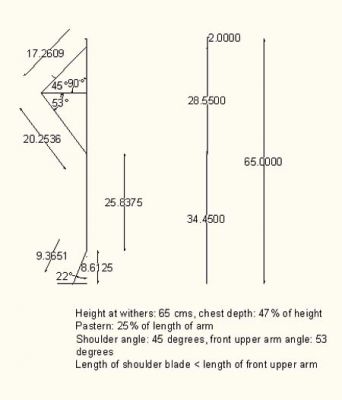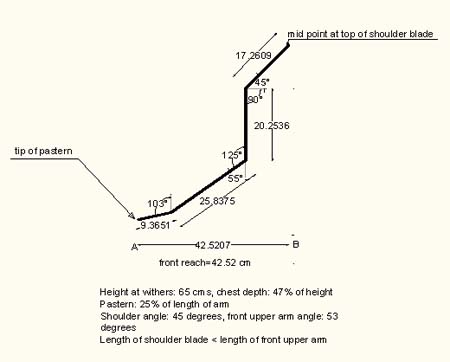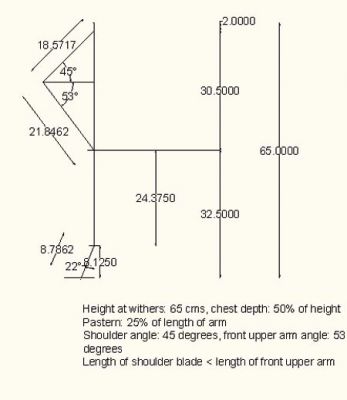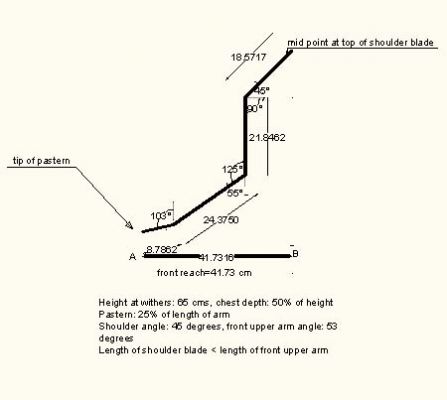
This is a placeholder text
Group text
by Ibrahim on 13 June 2012 - 17:06
Now let us look at a 47% chest dept, all lengths are calculated in same above explained method, but all angles remained the same.
Ok 47% chest depth standing, ideal shoulder

Ok 47% chest depth standing, ideal shoulder

by Ibrahim on 13 June 2012 - 17:06
Corresponding full reach


by Ibrahim on 13 June 2012 - 18:06
So between the reach of a 45% chest depth of a ideal GSD and a 47% chest depth of a ideal GSD there is a difference of 0.68 cm which represents decrease of approximately 1.5% of that reach of the latter in one stride. Not much of a decrease.
One interesting point
If you sum up all the lengths of bones of the ideal GSD of 45% chest depth you find it 72.49 cms.
And the sum up of the lengths of all bones in the fore assembly of the ideal GSD of 47% depth you find it 72.72 cms.
The difference is 0.23 cms which is approximately nothing. Just a side remark
One interesting point
If you sum up all the lengths of bones of the ideal GSD of 45% chest depth you find it 72.49 cms.
And the sum up of the lengths of all bones in the fore assembly of the ideal GSD of 47% depth you find it 72.72 cms.
The difference is 0.23 cms which is approximately nothing. Just a side remark
by Ibrahim on 13 June 2012 - 18:06
Let's see what happens when the chest is 50% of the height.
by Ibrahim on 13 June 2012 - 18:06
Ok 50% chest depth standing, ideal shoulder


by Ibrahim on 13 June 2012 - 18:06
Correspondent reach


by Ibrahim on 13 June 2012 - 18:06
So in case of an ideal GSD of 50% chest depth the fore front reach is 41.73 cms
that is a 1.84% less than that of the 47% chest depth GSD and 3.4% less than that of the 45% chest depth GSD and this is a valuable decrease. So those who said in the standard chest depth should not get more than 50% know what they're talking about. The more chest depth the less front reach and as it gets closer to 50% the decrease in front reach gets worse.
Lets see the sum of bone length, it's 73.5791, an increase of 0.86 cm to 2nd GSD and 1.0 cm from 1st GSD.
that is a 1.84% less than that of the 47% chest depth GSD and 3.4% less than that of the 45% chest depth GSD and this is a valuable decrease. So those who said in the standard chest depth should not get more than 50% know what they're talking about. The more chest depth the less front reach and as it gets closer to 50% the decrease in front reach gets worse.
Lets see the sum of bone length, it's 73.5791, an increase of 0.86 cm to 2nd GSD and 1.0 cm from 1st GSD.
by Ibrahim on 13 June 2012 - 19:06
Just to explain this 3.4% less fore reach, say when dog 1 and dog 3 cover a distance of 2000 meters with their front arms dog number one needs to make 4360 strides.
While dog 3 needs to make 4793 strides, that is 433 strides more, imagine the extra fatigue the 3rd GSD shall endure. So again this is the endurance and efficiency the standard talks about.
I want to highlight one important thing here, what I did is only make drawings to illustrate what the standard says, I'm not inventing a new thing or making a new theory here, no not at all, many explained this in papers, studies and books, what I am adding here is a simple demo to show the importance of correct conformation and give some due value to the people who wrote the standard, they know what they're talking about and they put their accumulated knowledge in the standard.
It would be nice if people share their knowledge of practical and actual experience of dogs in regards to effect of chest depth on the front reach. Thanks
While dog 3 needs to make 4793 strides, that is 433 strides more, imagine the extra fatigue the 3rd GSD shall endure. So again this is the endurance and efficiency the standard talks about.
I want to highlight one important thing here, what I did is only make drawings to illustrate what the standard says, I'm not inventing a new thing or making a new theory here, no not at all, many explained this in papers, studies and books, what I am adding here is a simple demo to show the importance of correct conformation and give some due value to the people who wrote the standard, they know what they're talking about and they put their accumulated knowledge in the standard.
It would be nice if people share their knowledge of practical and actual experience of dogs in regards to effect of chest depth on the front reach. Thanks
by Ibrahim on 13 June 2012 - 19:06
One last thing about effect of chest depth
For GSDs of same height at withers, same shouler angle, same front upper arm angle, same pastern proportion to front arm, same pastern angle, same well balanced fore assembly and same good open of joints in full fore reach
The deeper the chest
1. The less front reach
2. The longer the shoulder blade is
3. The longer the front upper arm is
4. The shorter the front arm/leg is
5. Ther shorter the pastern is
For GSDs of same height at withers, same shouler angle, same front upper arm angle, same pastern proportion to front arm, same pastern angle, same well balanced fore assembly and same good open of joints in full fore reach
The deeper the chest
1. The less front reach
2. The longer the shoulder blade is
3. The longer the front upper arm is
4. The shorter the front arm/leg is
5. Ther shorter the pastern is
by Ibrahim on 15 June 2012 - 08:06
So as shown above the less the chest depth and therefore the relatively (in terms of proportion) longer fore arm/front leg the better the front reach, going back to Dingo, he had a long front leg and a less chest depth, look
(1).jpg)
(1).jpg)
Contact information Disclaimer Privacy Statement Copyright Information Terms of Service Cookie policy ↑ Back to top





